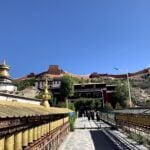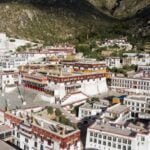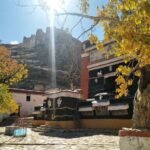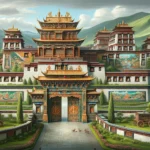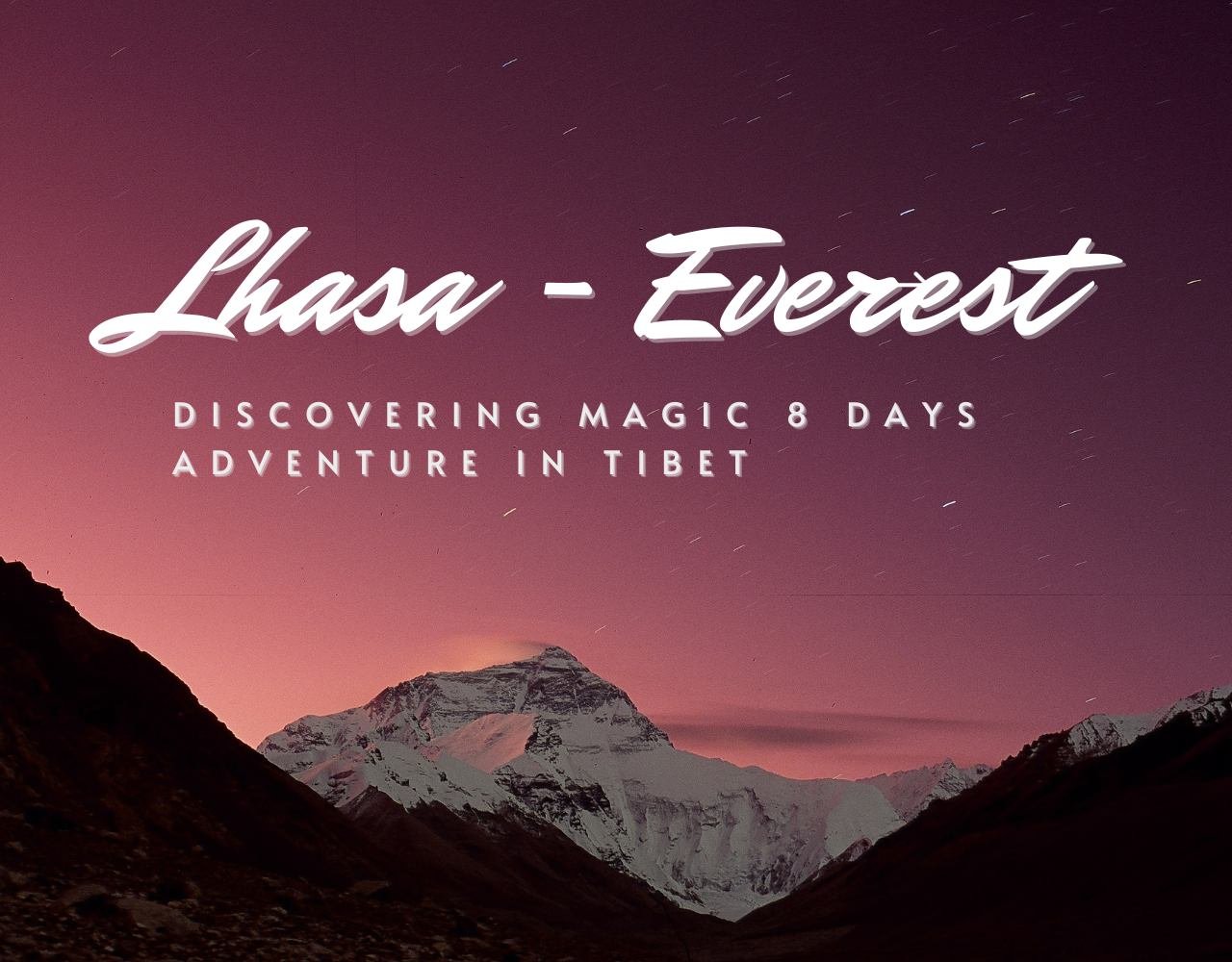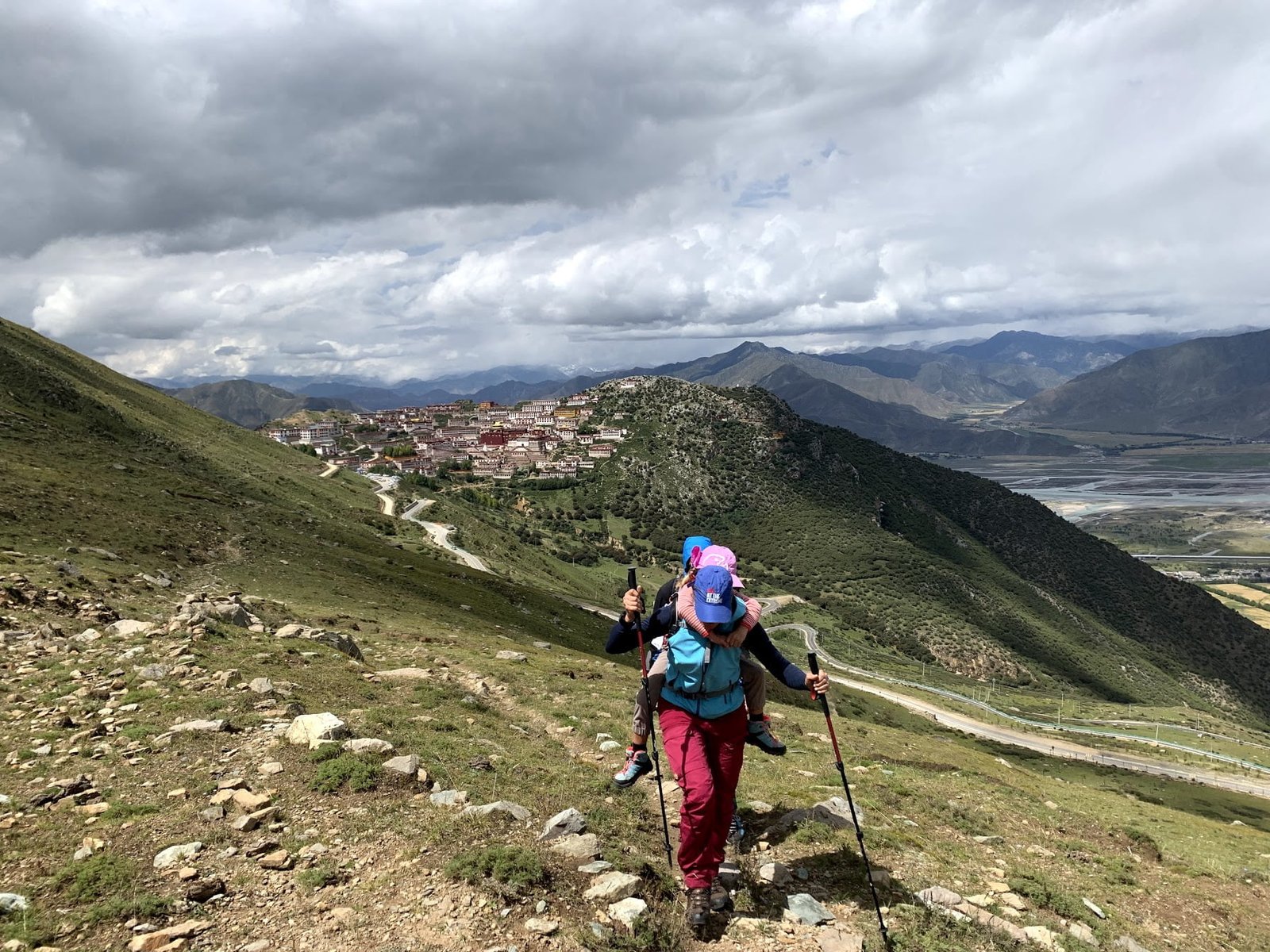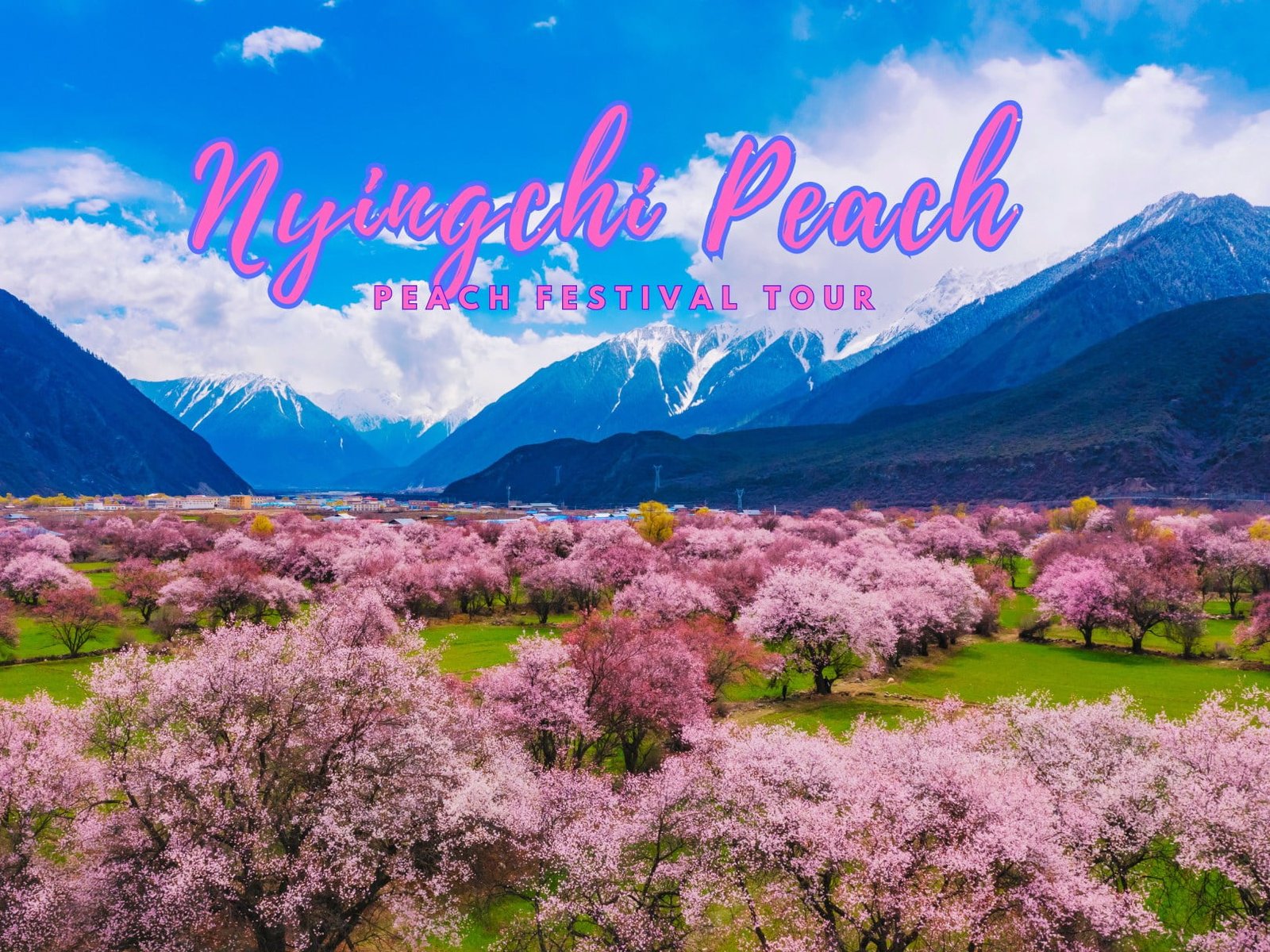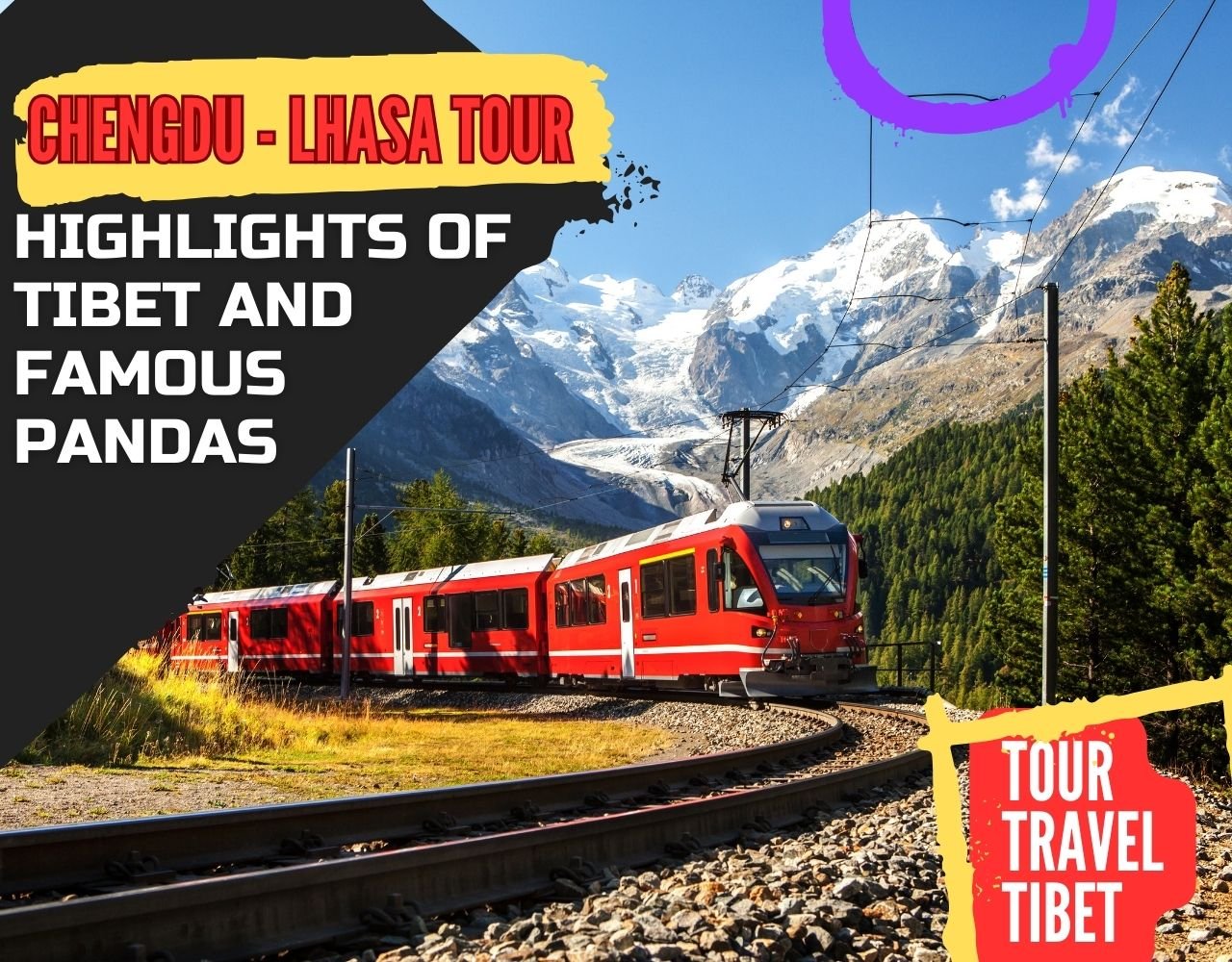Tashi Lhunpo Monastery, also known as “Auspicious Sumeru Temple”, its full name is “བཀྲ་ཤིས་ལྷུན་པོ་དཔལ་གྱི་བདེ་ཆེན་ཕྱོགས་ཐམས་ཅད་ལས་རྣམ་པར་རྒྱལ་བའི་གླིང”, is the largest monastery in the Shigatse area of Tibet, and is the place where successive Panchen Lamas after the fourth generation resided in Shigatse. The temple is located on the hillside of Niseri in the west of Shigatse City.
Tashi Lhunpo is the largest Monastery in the Shigatse area, and is one of the six largest Monasteries of the Gelug Sect, alongside Drepung Monastery, Sera Monastery, Gandan Monastery in Lhasa, Kumbum Monastery in Qinghai, and Labrang Monastery in southern Gansu.
Tashilhunpo Monastery is a vast temple with impressive golden roofs and red walls. It has 57 scripture halls and 3,600 houses. The temple is located on a mountainside with a towering peak behind it and faces the northern sun. Inside, visitors are greeted by purple incense smoke, flickering lights, and lifelike Buddhas. Built-in 1447 by the first Dalai Lama, it later became the residence of the Panchen Lama. The Monastery has attracted devotees for over five centuries and is home to various halls and pagodas, including the Tsokchen Hall and the Jampa Buddha Hall.

Tsokchen Assembly Hall
The Tsokchen Sutra Hall is the first structure built in Tashilhunpo Monastery, taking 12 years to finish. In front of it lies a lecture hall spanning over 600 square meters, where the Panchen Lama taught the monks and engaged them in scriptural debates.
The lecture hall is adorned with stone-cut Buddhist patriarchs, four heavenly kings, eighteen arhats, a variety of Buddha statues, eighty Buddhist eminent monks, as well as different flying fairies and Bodhisattvas.
In the Great Sutra Hall, vermilion lacquered pillars support the top of the hall and the Panchen Lama’s throne. Adjacent to the main hall is the Great Buddha Hall, expanded in 1461 AD with funding from Ngari Guge King Jiwu. Inside, an 11-meter-tall Maitreya Buddha statue was crafted by Tibetan artisans, portraying a kind and dignified expression. On the opposite side of the main hall lies the Tara Buddhist Hall, housing a 2-meter-tall bronze White Tara statue, accompanied by clay Green Tara statues. The interior of the sutra hall is paved with schists from the Himalayan foothills, creating an environment conducive to spiritual practice.
Gyana Lhakang, meaning “Han Buddha Hall,” is a unique Buddhist hall in Tibet. Inside, you can find a collection of rare artefacts, including ancient porcelain from the Yongle era, wine cups made of gold and silver, tea bowls, jade vessels, textiles, and various gifts bestowed upon the Panchen Lama by successive emperors. Additionally, there are nine bronze Buddha statues dating back to the Tang Dynasty. Notably, there is a bronze statue of a naked female Tara riding a wild boar from the Yuan Dynasty, as well as a 16.5 catty gold seal engraved with Chinese, Mongolian, and Tibetan script, gifted by the emperor of the Qing Dynasty to the Panchen Lama. Furthermore, the hall houses precious gemstones, Buddhist scriptures, and other sacred texts.
Shartse Dratsang,
One of the four big Dratsang is mainly used for wall portraits of Lama Tsongkhapa, gold-plated bronze statues of Sakyamuni and the six-armed patriarch. There are 24 pillars in the main hall of Dratsang. There are statues for Sakyamuni and his eight Boddhisatva.
Thoesamling Dratsang
There are 24 pillars in the main hall of Thoesamling Dratsang, which are divided into East and West Chapels. On the west side, there are Buddha statues of Sakyamuni, 11 head Avalokitesvara, Vajrapani, etc. On the east side, there are three statues of Buddha from past, present and future.
Ngaba Dratsang
Ngaba Dratsang is the esoteric School of the entire temple, constructed in 1615 by the fourth Panchen Lama. The Sutra hall features 16 columns and numerous murals adorn the inner wall. It houses the Vajra guru throne and Kunchok Gyaltsen’s Silver Pagoda.
Palace of Panchen lama
Tashilhunpo monastery is the residence of Panchen Lama and consists of four palaces. In 1660, the fourth Panchen Lama, Lobsang Chekyi Gyaltsen, became the 16th abbot of the temple and significantly expanded it. In 1645, Gushi Khan bestowed the title of “Panchen Bokeduo” upon Panchen Lobsang Choekyi Gyaltsen, and in 1713, the Qing government conferred the title “Panchen Erdeni” upon the fifth Panchen Lobsang Yeshi.

Great Maitreya Hall
The temple’s most magnificent buildings are the Great Maitreya Hall and the Panchen Lama Pagoda Hall. Located on the west side, the Great Maitreya Hall stands at a height of 30 meters. It houses the seated Maitreya statue, created by the Ninth Panchen Lama Choekyi Nyima in 1914. The hall is divided into five levels: lotus seat hall, waist hall, chest hall, face hall, and Crown hall, which are ascended by a wooden ladder. This 26.2-meter tall statue is composed of 231,400 kilos of brass and 6,700 kilos of gold.
The white hair inlaid between the eyebrows of Buddha statues only uses one extra-large diamond with a diameter of 3cm, 32 diamonds with a diameter of 1cm, over 300 large pearls, and over 1400 amber, coral, loose ear stone, etc., showcasing the cost and technological level. Undoubtedly, this is the largest bronze seated Buddha statue in existence. It took 4 years to cast this Buddha statue and 110 craftsmen.
On the other hand, the Panchen Lama pagodas vary in size and are adorned with pearls and jade. Each stupa is illuminated by perpetually lit butter lamps of different sizes throughout the year. The pagoda also houses the remains of the 10th Panchen Lama, with the stupa dedicated to the 4th Panchen Lama being the most opulent.
Rituals in Tashi Lhunpo Monastery
In addition to conducting rituals on auspicious days in the Tibetan calendar, Tashilhunpo Monastery also holds ceremonies during other Buddhist festivals such as the Monlam Festival, Saga Dawa, Lhabab Duechen, and Ganden Ngamchoe. These rituals aim to pray for the prosperity of Buddhism and the peace of all beings. The temple’s most notable festival is “Sermo Chenmo,” which resembles the “Shoton Festival” in Lhasa and serves as a celebration for both monks and ordinary individuals.
Sutras
In addition to the precious Buddha statues, pagodas, and thangkas, there are also handwritten leaf scriptures and “Kagyur” and “Tengyur” written in gold ink. Moreover, there is a wide array of porcelain, enamel, and glass artefacts. These invaluable treasures offer valuable insights into the political, religious, and social evolution of Tibet during different historical periods. Furthermore, the Monastery’s murals are exceptionally unique, showcasing diverse forms, vibrant colours, and exquisite brushwork. They stand as remarkable masterpieces of Buddhist art.
Tomb Stupa of the Tenth Panchen Rinpoche
The Stupa-tomb of the Tenth Panchen Lama is located east of the chapel. It is adorned with 614 kg (1,354 pounds) of gold, 868 precious stones, and 246,794 jewels. It was constructed in 1993. The nearby Panchen Lama’s Palace, a grand white palace, was primarily built during the reign of the Six Panchen Lama (1738-1780). It is not accessible to tourists or local visitors.
Tomb Stupa of Fourth Panchen lama
To the east of the Panchen Lama’s Palace lies the Stupa-tomb of the Fourth Panchen Lama who is one of the most famous Lamas in Tibetan history. He is also the teacher of the Fifth Dalai Lama. His gorgeous stupa-tomb decorated with gold and silver was built in 1662. The Stupa-tomb of the Fourth Panchen Lama is the first stupa-tomb in Tashilhunpo.
You can also find the combined buried Stupa-tombs of Panchen Lama from fifth to ninth, which is called Tashinanjie. This combined Stupa-tombs finished in January 1989 was sponsored by the Tenth Panchen Lama, in which lies the body of the last Panchen Lama and also the bronze of the Ninth Panchen.
Tashilhunpo Monastery has 8 Panchen Lama pagodas. During the “Cultural Revolution”, the 5th to 9th pagodas were destroyed. From 1985 to 1989, the 10th Panchen Lama rebuilt a co-burial pagoda hall for the 5th to 9th Panchen Lamas, naming it “Tashi Namgye” (auspicious heaven).
The fourth Panchen Lama’s stupa was reconstructed in the former fifth Panchen Lama’s mausoleum in the 1970s. The pagodas for the 1st to 3rd Panchen Lamas were not constructed in Tashilhunpo Monastery. The first Panchen Lama served as the third Chiba (abbot) of Ganden Monastery. After his demise, the pagoda was built in Ganden Monastery. The 2nd and 3rd Panchen Lamas served as Chiba in Engong Temple (Jiangdang Township, Kaze today), and after their passing, their stupas were all erected in Engong Temple.
The Kelsang Temple
The Great Courtyard of the Kelsang Temple is the place for lamas to practice and debate. The wall around the courtyard is covered by thousands of images of Sakyamuni in different postures and expressions.
Tsochin Hall, the largest and earliest building of Tashilhunpo Monastery, is centrally located within the temple complex. Constructed between 1447 and 1459, it can accommodate up to 3,800 monks. The main hall on the ground floor contains a gilded Buddha statue of Sakyamuni, which is housed within the Sutra hall. This statue is believed to contain Sakyamuni’s relics, as well as the skull of Gendun Zhuba’s scripture teacher, Sherab Sangye, and Tsongkhapa’s hair. Flanking the main Buddha statue are eight Boddhisatvas.
The Jamba Buddha Hall, funded by Ngari Guge King in 1461, is located on the left side of the ground floor. Standing 11 meters tall, it is accompanied by statues of Avalokitesvara and Manjushri, crafted by the fourth Panchen Lama. Adjacent to the main hall is the Great Sutra Hall, capable of accommodating 2,000 lamas for prayer and scripture recitation. Outside the Tsochin main hall, there is a lecture hall in the form of a courtyard. In the past, the Panchen Lama frequently delivered sermons to the monks in this temple. During weekdays, the lamas gather in the main hall before lunch for scripture study and engage in scriptural debates in the afternoon.
List of Panchen Lama
- First Panchen Kedrup Geleg Palsang (1385-1438)
- Second Panchen Sonam Choklang (1439-1504)
- Third Panchen Ensapa Losang Dhondrup (1505-1566)
- Fourth Panchen Lobsang Choekyi Gyaltsen (1567-1662)
- Fifth Panchen Lobsang Yeshi (1663-1737)
- Sixth Panchen Palden Yeshi (1738-1780)
- Seventh Panchen Tenpe Nyima 1781-1853)
- The Eighth Panchen Tenpe Wangchuk (1854-1882)
- Ninth Panchen Choekyi Nyima (1883-1937)
- Tenth Panchen Chokyi Gyaltsen (1938-1989 )
- Eleventh Panchen ??


